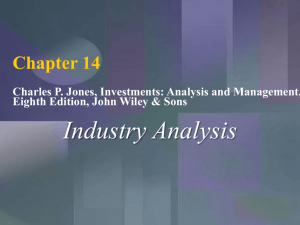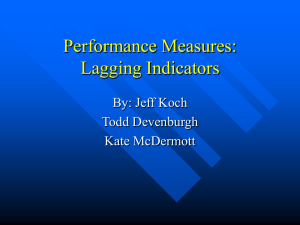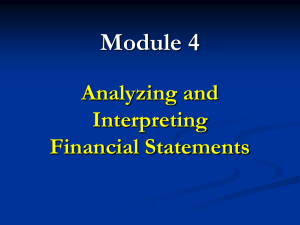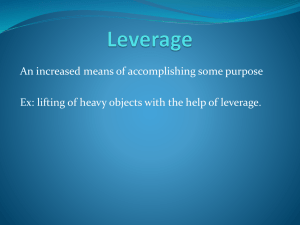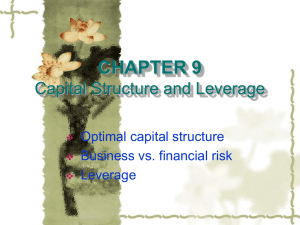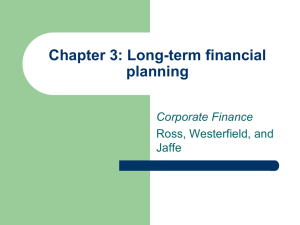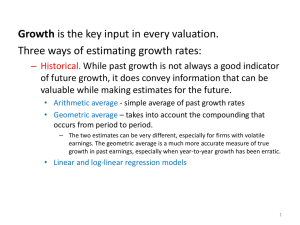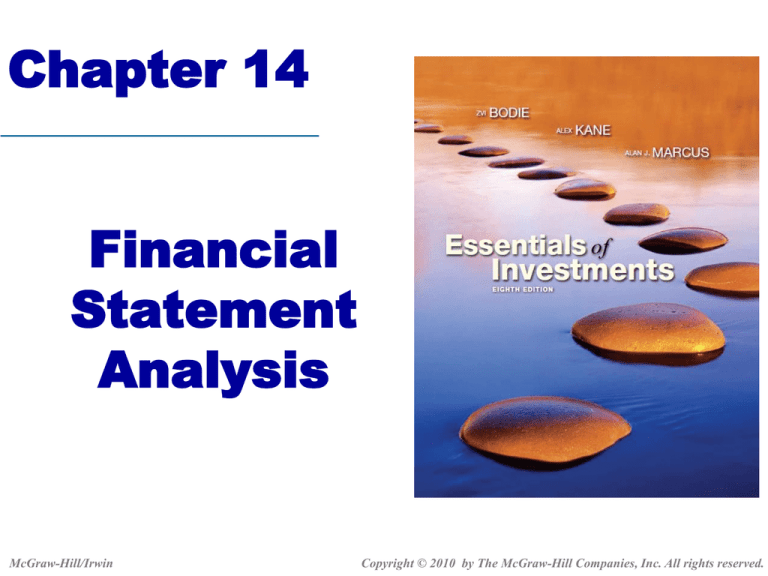
Chapter 14
Financial
Statement
Analysis
McGraw-Hill/Irwin
Copyright © 2010 by The McGraw-Hill Companies, Inc. All rights reserved.
Chapter 14
Financial Statement Analysis
14-2
14.1 The Major Financial Statements
1.Income statement
2.Balance sheet
3.Statement of cash flows
14-3
Income Statement
• Four broad types of accounts:
– Cost of goods sold
– General and administrative expenses
– Interest expense
– Taxes on earnings
• Common Size income statements
– Divide each account by net sales
– Eliminates size distortions
14-4
Table 14.1 Consolidated Statement of Income
14-5
Balance Sheet
• Assets
– Current
– Long-term
• Liability (current and long term) and
stockholders’ equity
• Common size balance sheet
– Divide each account by total assets
– Each account presented as a percent of the
total
14-6
Table 14.2 Consolidated Balance Sheet A
14-7
Table 14.2 Consolidated Balance Sheet B
14-8
Statement of Cash Flows
• A financial statement showing a firm’s
cash receipts and cash payments during a
specified period.
– Recognizes transactions only if cash changes
hands.
– “Undoes” much of accrual accounting to get at
cash changes
– Does not allocate capital expenditures
through time via depreciation as income
statement does
14-9
Statement of Cash Flows
Three main sections
• Cash flow related to operations
• Cash flow related to investing
• Cash flow related to financing
• Allows the analyst to understand which of
the firm’s activities are using and which
generating cash.
14-10
Statement of Cash Flows
• Not all sources of cash are equally sustainable.
– Would you rather invest in a firm that is primarily
generating cash through operations or through financing?
• It is difficult to evaluate whether the amount of
cash flow related to investing is ‘good’ or ‘bad.’
What else would we need to know?
– Rate of return on the investment
– Comparable data over time or from competitors
14-11
Table 14.3 Consolidated Statement of Cash Flows
14-12
Financial Leverage and ROE
• The relationship among ROE, ROA, and
leverage:
• ROE = Net Profits / Equity
• ROA = EBIT / Total Assets
D ebt
R O E (1 T ax rate) R O A ( R O A Interest rate)
E
quity
14-17
14.4 Ratio Analysis
14-20
Ratio Analysis
• Purpose of Ratio Analysis
– Understand the factors that affect performance
• Methods
– Trend analysis
– Comparative analysis
– Combination of the two
• Use by External Analysts
– Important information for investment community
– Important for credit markets
14-21
DuPont Decomposition of ROE
ROE can be decomposed into various ratios that reflect
different aspects of a firm’s performance:
ROE
Net Profit
Pretax Profit
(1)
Tax
Burden
Pretax Profit
EBIT
EBIT
Sales
(2)
Interest
(3)
Sales
Assets
(4)
Assets
Equity
Margin Turnover
(5)
Leverage
Burden
14-22
DuPont Decomposition of ROE
ROE
Net Profit
Pretax Profit
(1)
Tax
Burden
Pretax Profit
EBIT
(2)
Interest
EBIT
Sales
(3)
Sales
Assets
(4)
Assets
Equity
Margin Turnover
(5)
Leverage
Burden
• Ratio (1) Tax Burden (TB):
– Measures the percentage of pretax profit that the firm keeps after
paying taxes
• Ratio (2) Interest Burden (IB):
– Measures the percent of EBIT kept after paying interest expense
Pretax Profit
EBIT Interest Expense
–
EBIT
EBIT
– This ratio is 1 if the firm has no debt
14-23
DuPont Decomposition of ROE
ROE
Net Profit
Pretax Profit
(1)
Tax
Burden
Pretax Profit
EBIT
(2)
Interest
EBIT
Sales
(3)
Sales
Assets
(4)
Assets
Equity
Margin Turnover
(5)
Leverage
Burden
• Ratio (3) Operating Profit Margin
– Measures the percentage of sales revenue that remains after
subtracting cost of goods sold, selling and administrative
expenses and depreciation
• Ratio (4) Asset Turnover Ratio (ATO)
– Measures the efficiency of the firm at generating sales per dollar
invested in the assets
– Note: Margin x ATO = ROA
14-24
DuPont Decomposition of ROE
ROE
Net Profit
Pretax Profit
(1)
Tax
Burden
Pretax Profit
EBIT
(2)
Interest
EBIT
Sales
(3)
Sales
Assets
(4)
Assets
Equity
Margin Turnover
(5)
Leverage
Burden
• Ratio (5) Leverage ratio
– Leverage ratio = 1 + Debt / Equity
– The leverage ratio is a measure of the percentage of debt
in total capitalization.
– Note that it appears that using more debt as a percent of
capital will increase ROE, but using more debt also
reduces the interest burden ratio
14-25
DuPont Decomposition of ROE
ROE
Net Profit
Pretax Profit
(1)
Tax
Burden
Pretax Profit
EBIT
(2)
Interest
EBIT
Sales
(3)
Sales
Assets
(4)
Assets
Equity
Margin Turnover
(5)
Leverage
Burden
• Compound leverage factor (CLF)
–
–
–
–
= Interest burden x Leverage
If the CLF > 1, the use of debt will increase ROE
If the CLF < 1, the use of debt will decrease ROE
CLF will be greater than 1 if ROA > Interest rate on debt
What does this imply about when firms should use more debt?
14-26
More on Ratios
14-28
Ratio Analysis using GI
Asset Utilization Ratios (2010 data for GI)
Sales
1. Total Asset Turnover
$144,000
($518,400
Avg. Assets
2. Fixed Asset Turnover
3. Inventory Turnover
Sales
4 32 ,000 )/2
$144,000
Avg. Fixed Assets
($259,200
Cost of Goods Sold
Average Inventory
216,000)/2
$79,200
($ 1 29,600 108,000)/2
. 303
. 606
Industry
Average
0.40
0.70
. 485
0.50
4. Average collection period or days sales in receivables
Avg. Accounts
Receivable
Sales / 365
s
($43,200 $36,000)/2
$144,000 / 365
100.4 days
60 days
How will these ratios affect ROA and ROE?
14-29
Ratio Analysis using GI
Liquidity Ratios (2010 data for GI)
1. Current Ratio
Current Assets
Current
2. Quick (Acid Test)
3. Cash ratio
Current
Liabilitie s
Assets - Inventory
Current Liabilitie s
Cash Marketable
Securities
Current Liabilitie s
$259,200
Industry
Average
2.0
. 97
$ 266 ,272
$259,200
- $129,600
. 49
$266,272
$86,400 $43,200
$266,272
. 324
1.0
0.70
14-30
Ratio Analysis using GI
Market Price Ratios (2010 data for GI)
$21.00
1.Market-to-Book Price stock
. 1186
$ 177 ,128 / 1,000
Book Value/sha
2.P/E ratio
3.ROE
Also:
re
Price stock
$21.00
$5,285/1,0
Earnings/s hare
Net Income
$ 5,285
Equity at Book Value
$177,128
ROE
P/B
P/E
.1186
Industry
Average
.69
3 . 97
00
2 . 98 %
8.0
8.64%
2.98%
3.97
14-31
Economic Value Added
K = 12%
E1 = $1Book Value $8.33
PLOUGH BACK RATIOS
Growth Rates
10%
12%
14%
0%
0.0%
0.0%
0.0%
25%
2.5%
3.0%
3.5%
50%
5.0%
6.0%
7.0%
75%
7.5%
9.0%
10.5%
10%
12%
14%
0%
8.33
8.33
8.33
25%
7.89
8.33
8.82
50%
7.14
8.33
10.00
75%
5.56
8.33
16.67
10%
12%
14%
0%
1.00
1.00
1.00
25%
0.95
1.00
1.06
50%
0.86
1.00
1.20
75%
0.67
1.00
2.00
Price
P/BV
14.6An Illustration of Financial
Statement Analysis
14-39
Table 14.12 Key Financial Ratios of Growth Industries (GI)
2010 annual report claimed that GI had a successful year, stating that
as in the year before, sales, assets and operating income all continued
to grow at 20%. Is the report correct?
14-40
Table 14.13 GI Statement of Cash Flows
14-41
14.7 Comparability Problems
14-42
Comparability Problems
Ratios must have a benchmark, but it can be difficult to
compare data of different firms
• Different inventory valuation
– LIFO and FIFO
• Depreciation problems
– Accounting depreciation Economic depreciation
– Different depreciation methods at different firms
– In periods of inflation depreciation is understated in economic
terms and real economic income is overstated
14-43
Comparability Problems
• Inflation and interest expense
– Nominal interest rates include an inflation
premium to compensate for erosion in the real
value of the principal.
– Conceptually then, from an economic
viewpoint part of interest expense is actually
principal repayment.
14-44
Fair Value Accounting
Fair value accounting uses market values
rather than book values in the firm’s
financial statements.
– Market value is a truer picture of the current
value of the firm,
– Market value is forward looking, book value is
backward looking
– Trend is toward market value accounting
14-45
Fair Value Accounting
Financial Accounting Standards Board (FASB)
Rule 157 classifies assets in one of three buckets:
– Level 1: Assets that are traded in active markets and
should be valued at market prices
– Level 2: Asset that are not actively traded, but their values
may be estimated from market data on similar assets
– Level 3: Assets that can only be valued with inputs that are
difficult to observe.
•Level 2 and Level 3 assets may be valued using
pricing models and the values may be ‘marked to
model’
14-46
Quality of Earnings: Accounting
Choices
Quality of earnings refers to the realism and
sustainability of reported earnings,
• Allowance for bad debts must be realistic
• Extraordinary and Non-recurring items are
sometimes pretty ordinary and common
• Earnings smoothing is pervasive
– Revenue & expense recognition options
– Engaging in contingent off-balance sheet assets
(certain leases) or liabilities (selling credit default
swaps) that have unknowable effects on earnings
14-47
International Accounting Conventions
• Reserving practices
– Overseas firms have far more discretion in their ability to set
aside reserves for future contingencies (or not) than U.S. firms
have.
– This means foreign firms’ earnings are more subject to
managerial manipulation
• Depreciation
– Foreign firms typically use accelerated depreciation on their
financial statements and U.S. firms don’t, so foreign firms have
lower reported earnings, ceteris paribus.
14-48
International Accounting Conventions
• Intangibles
– Treatment of intangibles varies widely
between countries.
14-49
Figure 14.2 Adjusted Versus
Reported Price-Earnings Ratios
14-50
IFRS
The International Financial Reporting Standards (IFRS) have
been adopted by the European Union and by over 100 countries.
• In 2007 the SEC began allowing foreign firms to list their
securities in U.S. markets if they prepared their statements using
IFRS
• In 2008 the SEC ruled that large U.S. multinational firms may
start using IFRS rather than GAAP in 2010 and that all firms
should use IFRS by 2014.
• IFRS standards are principle based rather than rules based
14-51
14.8 Value Investing: The Graham
Technique
14-52
Benjamin Graham
• Founder of modern fundamental analysis
• Graham believed careful analysis of a firm’s financial
statements could turn up bargain stocks and his work
was used by generations of analysts
• He developed many different rules for determining the
most important financial ratios, as his ideas became
popular they stopped working.
14-53

